11 tips for laying your own lawn Lawn roll device
See how summer plots have changed over the past 30-40 years! Many summer residents decided to abandon the vegetable beds and turn the cottage into a resting place. So, beautiful flower gardens and chic lawns. A neat green lawn is an ideal place for picnics, sunbathing and children's games. Moreover, it is also a decoration of the site. To grow a chic lawn, it will take at least one year. If time does not endure, or you want to admire the thick greens of grass immediately, then you can cheat and use the grass that has already been grown for you. Let's try to deal with the device of a rolled lawn, to determine its pros, cons and features. Looking ahead, we note that it is very simple to organize such coverage on your site. To make sure of this, we will tell you in detail how to lay a rolled lawn with your own hands.
No. 1. Types of Roll Lawn
Rolled lawn makes it possible in the shortest time, organize the perfect grass cover almost anywhere, which is its main advantage. He found application in various fields, so today it is customary to single out such main types of rolled lawn:
- ground floor. It is distinguished by the highest decorative qualities, it has a uniform color, velvety surface, very dense. The main disadvantage is sensitivity to excess moisture, lack of sun and other factors. This is a very capricious coating, which is used to decorate the local area. Walking on such a lawn is strictly prohibited - he will not bear such an impact. In the country, it can only be used to decorate flower beds, but specific care will also be required;

- sports lawn It is intended for the arrangement of football fields, sports fields and other territories with a high load. Coverage consists mainly of herbs such as ryegrass and bluegrass. This mixture is very resistant to trampling and other negative factors, but this does not mean that you do not need to take care of such a lawn. You can use it for organization playground in the country;

- universal lawn received the most popularity. It is precisely him who is used in cottages, because he is well resistant to various weather factors and can withstand an active load, so that you can run along it without problems. You can use the lawn almost everywhere, and in the country it will become both a decoration of the site, and a place for picnic.

No. 2. Advantages and disadvantages of a rolled lawn
What makes a rolled lawn so popular among summer residents? The answer to this question lies in the listing main advantages of coating:
- minimum time to organize a lawn. If the estimated area of the lawn is small, then the coating can be created in one day;
- uniformity, density, the intensity of the color of the rolled lawn, because it is grown on special farms using a mass of equipment that is not available in the ordinary summer resident. At home, it is much more difficult to grow such a high-quality coating;

- relative ease of care. The rolled lawn gets to your site already 3 years old, i.e. he managed to accumulate enough strength to better resist the negative environmental factors. Experienced summer residents say that in such a cover for the first time even weeds do not grow;
- watering a rolled lawn can be performed less frequently than a sowing lawn, and fertilizers are much simpler;
- a rolled lawn requires only 8-10 cm of fertile soil. For a sowing lawn, this figure is at least 20 cm.
You can also talk about the unpretentiousness of a rolled lawn, about the possibility of using it on uneven surfaces and in shady places, wherever a regular lawn has sprouted. The only negative is the high price, but many rightly believe that it pays off with a guaranteed result, elegant coverage, minimal time investment and easy maintenance.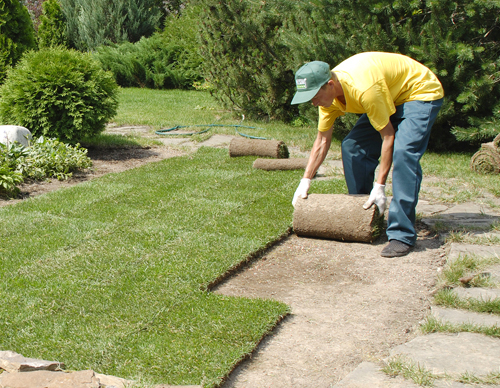
No. 3. How to grow a rolled lawn?
In short, then a rolled lawn is an ordinary sowing season, only a company specializing in this sows it for you, takes care of it for three years, wateres, fertilizes and cuts it, and then cuts it into small fragments together with turf. They are sold to the buyer, who then spreads the finished lawn in his country house: the roots of the grass grow in the ground, and a full-fledged coating comes out. Here is such a simple transplant!
Now information for those who crave details. Rolled grass is grown in a special large area nursery using special equipment. From the time of sowing to sale takes 1.5-3 years, it’s better to take a 3-year-old lawn, because it already has a well-formed root system, and the grass cover itself is quite dense.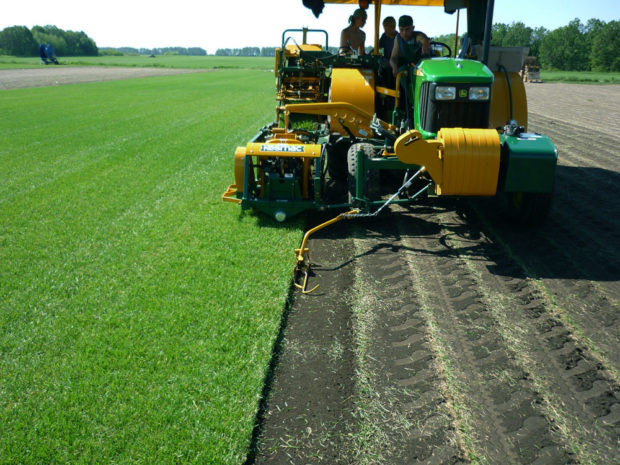
Depending on growing technology roll lawn can be of two types:
- using mesh. In this case, a grid of agrofibre is laid out over the entire area of the future coating, and only then does the seed sow. As a result, the roots of the grass reliably intertwine with the net, forming a durable lawn that is easy to transport without any special consequences;
- without mesh. In this case, no additional devices are used, and the strength of the roll is ultimately provided only by the roots of the plants and their plexus. In principle, the turf is reliable enough to cut off the cover and transport it. In terms of cultivation and transportation, such a lawn is still more demanding, but fans of all natural prefer this coating.

Except for this moment, then the technology for growing a rolled lawn on all farms is the same:
- preparation of the soil in order to loosen it and break the lumps. To do this, use a cultivator or a plow, then large particles of the earth are broken with a harrow;
- soil treatment with herbicides in order to destroy all weeds in the area where the lawn will be grown;
- if the lawn will grow on the grid, then it is laid out at this stage, taking into account the size of the future coating and the features of the irrigation system;
- sowing with a prepared mixture of seeds;
- proper fertilizer and watering for several years;
- regular haircut, so that the cover becomes dense, and the roots are well intertwined;
- cutting the finished lawn, folding into a roll and transportation.
Cutting grass with the base occurs on the eve of transportation. Ideally, no more than a day should pass from cutting to laying, otherwise the roots of the grass will dry out, which will lead to the death of the lawn. If it is not possible to quickly transport and lay the coating, then it is placed in a refrigerator, where it can live no more than 4 days.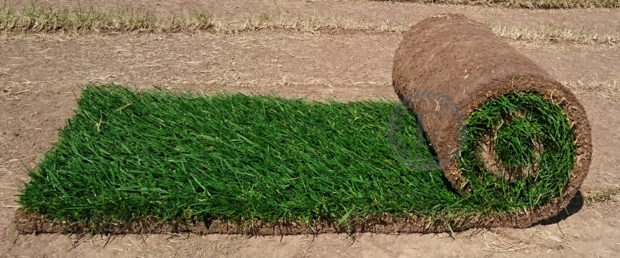
Number 4. Sizes of a rolled lawn
As a rule, grass is cut along with the base fragments 2 m long and 40 cm wide, but these parameters may vary slightly from one manufacturer to another. Width rarely exceeds 48 cm. With these dimensions, the lawn is easy to cut, roll, and transport. The thickness of the lawn should be 2-4 cm, meaning turf.The height of the blades of grass, as a rule, reaches 6-7 cm.
Lawns for special purposes may have completely different parameters. For example, a sports lawn is sold in rolls 1 m wide and up to 15 m long.
As for lawn weights, then the exact figure is difficult to name here - a lot depends on soil moisture. 1 m average2 The coating weighs 17-25 kg. It turns out that a truck with a carrying capacity of 20 tons will be able to transport about 700 m at a time2 and more roll coating.
No. 5. What herbs are used?
You do not need to be an agronomist or a gardener with experience in order to understand that the main operational qualities of a lawn depend on what herbs are present in its composition. Manufacturers select a mixture so as to provide certain qualities to the coating, i.e. the composition of the grass will be different for each type of lawn. If we talk about the most popular universal lawn, the mixture often consists of such crops:
- bluegrass meadow Is a culture with emerald-colored grass. The lawn, which is 100% made of such grass, belongs to the premium segment, but requires careful care, especially in the first three years, but in the end it turns out a great finish. The composition of the universal coating is only part of this culture;
- red fescue differs in the increased resistance to trampling, does not dry, does not turn yellow, well tolerates a haircut. This is a persistent and unpretentious culture, the root system of which is developing quite intensively, due to which the slow growth of bluegrass is compensated;
- perennial ryegrass gives a dense grass cover in the first year. Culture lives for only three years, so it gradually gives way to other herbs, but the purpose of its use in our business is precisely to provide a dense coating at a time when other cultures are only gaining strength.
The composition of the herbs may vary, but most manufacturers take fescue and bluegrass as the basis. If the mixture contains other herbs, do not forget to find information about them in order to understand what awaits you in the end.
No. 6. How to understand that you have a quality rolled lawn?
Each manufacturer almost swears that his lawn is of the highest quality and almost immortal. Is this really so, each of us can check in person, and to do this, you just need to be careful enough, and pay attention to the following aspects:
- cut quality. The thickness of the base over the entire area of the lawn should be the same, the roots should be reliably intertwined and form, as it were, an integral pillow. Necessarily the presence of young white roots;
- the soil without stones, not overly clayey and not sandy;
- weeds, bald spots and yellowed spots are not acceptable;
- Blades of grass should be the same size, density - 100 or more shoots per 10 cm2. To quickly evaluate this indicator, you can attach a cigarette pack to the lawn and calculate the number of shoots - there must be at least 50;
- lack of pests and diseases;
- it is better to take a recently mowed lawn, as under long blades of grass small-leaved weeds may be hidden;
- experienced summer residents are advised to carefully take the grass cover near the edge and pull it, very slightly, without applying excessive effort. Grass should not be pulled out. If this happens, then it has weak roots and it will be impossible to get a good lawn.
Doesn't bother to look at the documentation, the presence of which indicates the integrity and seriousness of the seller, allows you to verify the regularity of lawn checks for quality. When you familiarize yourself with the documents, pay special attention to the place where the grass was grown to make sure that your future lawn grew from an area with a favorable environmental situation.
Number 7. How many rolls do you need to buy?
If you know the area of the territory that needs to be decorated with a lawn, and the area of each individual roll, then calculating how many rolls will be needed is a task for a second-grade student.From the manufacturer you need to find out the area of one roll of the selected lawn, or take the length and width parameters, and then multiply them.
The next step is to determine the area of the plot given to the lawn. If this territory has the shape of a regular square or rectangle, then the task is simplified as much as possible. It is necessary to determine the area of this site and divide it by the area of one unit of lawn roll.
Example. They sell us a lawn in rolls 2 m long and 40 cm wide. The area of one sample is 2 * 0.4 = 0.8 m2. We need to lay a lawn on a site with parameters 6 * 5 m, i.e. area 30 m2. To cover this area, you need 30 / 0.8 = 37.5 rolls, rounded up to 38. In this case, 5% is provided for the stock. It turns out that we need to order 40 rolls.
If the shape of the plot is complexIf there are curved lines, bends and other details, it is better to draw a plan on paper and draw a lawn layout diagram. You will have to literally draw each of the rolls to visually see how many of them are needed. You can do it in another way. From the school geometry course, we remember how to look for the area of a complex figure. It is necessary to break it into simple figures and find the area of each of them. This is what they do, and then they act according to an already familiar scheme, only in this case 10% of the result is added to the stock, since in the presence of bends and tracks material consumption will be higher.
Number 8. When can I lay a lawn roll?
Manufacturers say roll lawn can be laid at any time of the year, starting from early spring and ending in late autumn. In principle, the way it is, but laying in the autumn period has a lot of features, and if possible, it is better to refuse such an undertaking.
The best time is springwhen the soil is no longer frozen and not oversaturated with excessive moisture. At this time of the year the grass grows actively, so in the summer you will receive a luxurious thick green lawn, as from the picture.
Fall laying the lawn is possible provided that in the region the autumn is usually warm, long and soft. The grass will grow and gain strength until the moment when the air temperature drops to +50C. Up to this point, the shoots of grass can already grow enough, so they will protect the roots of the grass from winter frosts. In the spring, one difficulty may lie in wait for you: it will be difficult for young shoots to break through the layer of last year's grass, so in the end the lawn can turn out to be uneven.
Difficulties can arise when laying a lawn in summer. In general, it is better not to do this, since transplanting is already a big stress for the grass, and when the temperatures are high, the risk of drying the rolls is increased. If you can’t wait, you’ll have to water the lawn very often, up to two times a day, so that the sod well grows together with the soil, since the roots still cannot get enough moisture from the soil.
No. 9. Soil preparation for laying a roll lawn
Now let's get to the fun part. When everything is counted and selected, all the pros and cons are weighed, the moment of laying the lawn roll comes. It all starts with proper soil preparation on the site. As you might have guessed, just throwing a lawn roll across the territory will not work - the probability that it will take root in this case is low. Given the fact that the brought lawn must be laid on the same day, then the preparation of the territory must begin in advance.
The sequence of actions is as follows:
- to clear and dig the site, remove the roots of perennial weeds. For guarantee, herbicide treatment can be carried out;
- make measurements using the level. If there are areas with a strong slope, it is better to sprinkle them with earth so that in the future water does not accumulate there;
- add an additional fertile soil layer 5 cm thick on top, you can add dolomite and peat to it. This stage can be replaced by the use of special fertilizers for lawns. They are scattered around the site, and then carefully raked into the ground;
- tamper with a homemade lawn roller or wide board. The goal is to finally level the surface and compact the loose soil to prevent subsidence. Checking the quality of the tamper is simple: you have to step on the ground, and if there are no traces on it, then everything is fine. If the trace remains, then you can once again ramming;

- take into account that the roll lawn has its own thickness of 2-4 cm. As a result, the site should be flush with garden paths, so a fully prepared site should be 2-4 cm below the desired level;
- in lowland areas and high clay soils, it may be necessary to organize drainage, as the lawn does not like excessive moisture. Drainage is easy. 40 cm of soil is removed from the site, it is stored for later use. 10 cm of gravel and 10 cm of sand are filled into the bottom (instead of sand, you can use geotextile), then they fill the soil with the stored level.

No. 10. How to lay a rolled lawn with your own hands?
To do all the work yourself is not difficult:
- follow the rule "laying on the day of delivery";
- You can start laying from the part of the site where you folded the rolls;

- we put the first roll exactly in the corner of the platform, then carefully unwind it, trying to do it as evenly as possible;
- it is impossible to stretch, bend, twist the roll. If somewhere in the path of the lawn there is an obstacle, or the roll is longer than necessary, cut it with a knife or spatula;
- the next roll is laid end to end to the previous one, without overlapping the edges and leaving no gaps of more than 1.5 cm;

- when the first row is laid out, they start laying the second, but it is better to use chess stitching, i.e. Shift each new element half a roll relative to the previous one. To make it work, the laying of a new row begins with a roll that is shorter than the standard length. It looks like brickwork;

- edges are the weakest point in terms of survival, so it is not allowed to use small sections of rolls for their installation. Fragments of less than 1 m are best used in the center of the site, and lay out the edges with rolls of more than 1 m;
- when the first row is laid, it is gently rammed with a board to ensure full contact of the turf with the ground. Iron the coating with your hands to see if there are pits under the base. If there are any, then it is better to raise the roll and add soil;
- a fragment of a suitable shape is cut out from the turf to cover the areas of a complex-shaped site;
- if for laying new rows it is necessary to go through the newly laid lawn, then it is better to lay a dense board on it so as not to stomp on the fresh coating;

- seams are best covered with fertile soil. For clay soils, it is recommended to take peat, loam and sand in a ratio of 1: 2: 4, for sandy soils - in a ratio of 2: 4: 1, for peat soils use a mixture of peat and sand in a ratio of 3: 1.
What to do if the lawn is delivered, but it is impossible to lay it on the same day, or it turns out, but not all? To try to extend the life of the grass, unwind the rolls, moisten them and protect them from the sun, and be sure to start laying the next day.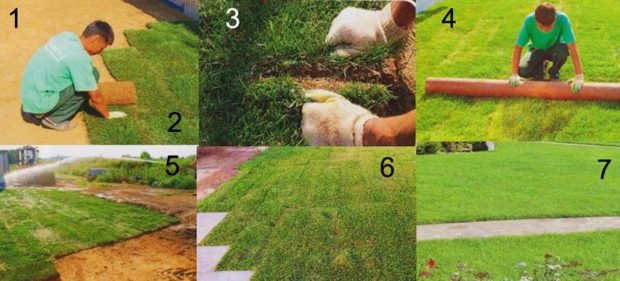
No. 11. Lawn care after laying
The main secret of good survival of a roll coating is high-quality hydration. When the laying work is completed, water the lawn abundantly at the rate of 1 bucket of water for every 1 m2 surface. If you slightly raise one of the rolls over the edge, you can see wet sod and moistened soil in the area. In this case, watering is done correctly.
In the next 2 weeks, the lawn should be watered every day, trying to prevent the soil from drying out. Ideally exercise automatic spraying. It is better not to walk on the lawn during the first month, and you can use boards to move around, which should be removed immediately after the transition is over. During this period, sod is fused to the ground.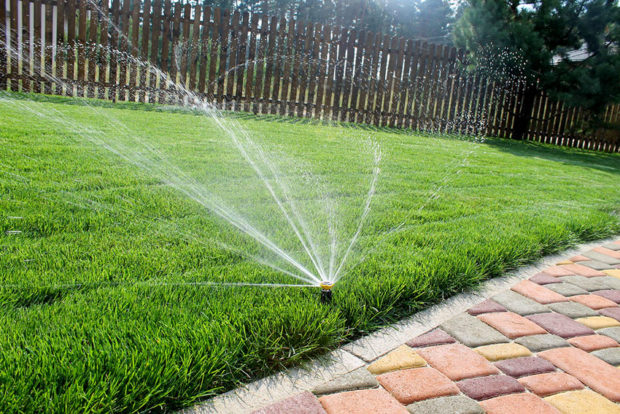
Further care looks like this:
- 4 weeks after laying, you can carry out the first haircut, but cut off only the tops, leaving the length of the blades of grass at 6 cm. Later, you can choose any desired length, but it is better to lower the knives in the lawn mower gradually;
- watch for weeds and pull them out right away. In the future, this problem will become less relevant, since the root system of lawn grasses will strengthen, become dense and will not miss weeds;
- watering is carried out as the soil dries. In the absence of precipitation, focus on the frequency of watering 1-2 times in 10-12 days;
- haircuts are carried out from April-May to October. In wet periods, the haircut is carried out more often, in the summer - less often, and the knives of the lawn mower at this time are placed higher than usual;
- Before wintering, it is necessary to trim so that the grass has time to grow at least 4 cm. In this case, the root system will be reliably protected from snow;
- before the onset of winter, the lawn is cleaned of all debris and fallen leaves;
- from the second year after laying before irrigation, mineral fertilizing can be carried out.

The green lawn will fit perfectly into any landscape design, goes well with flower beds, flower beds, shrubs and even beds. The easiest and fastest way to ennoble your own plot is to use a roll lawn. In a month you will be able to run on it, sunbathe and arrange cozy family picnics.

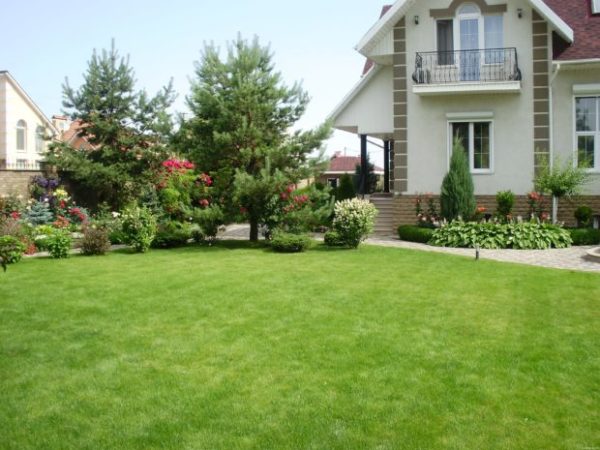

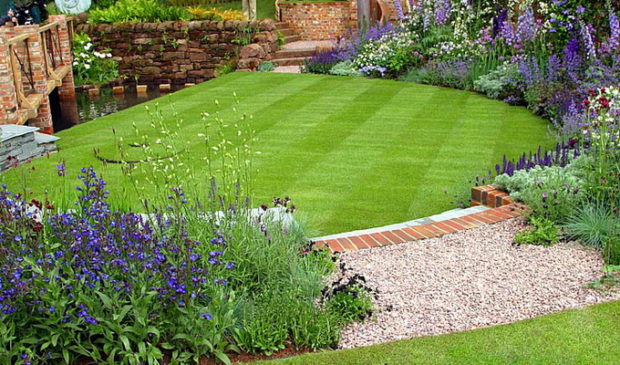
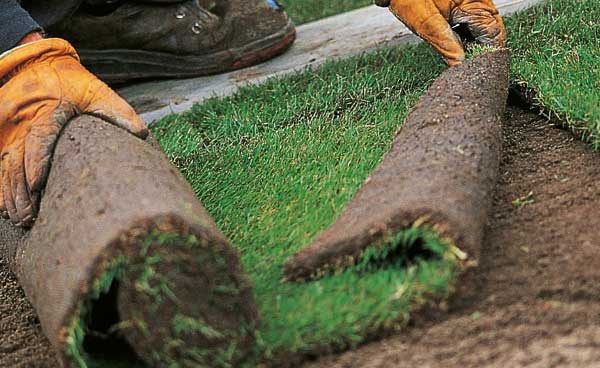
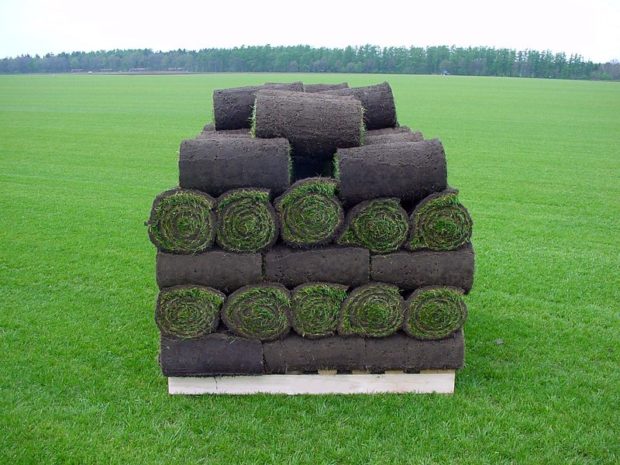
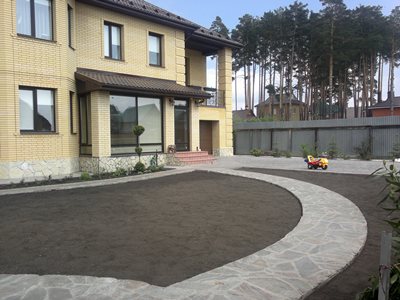
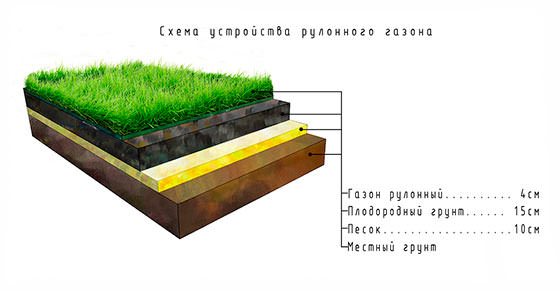
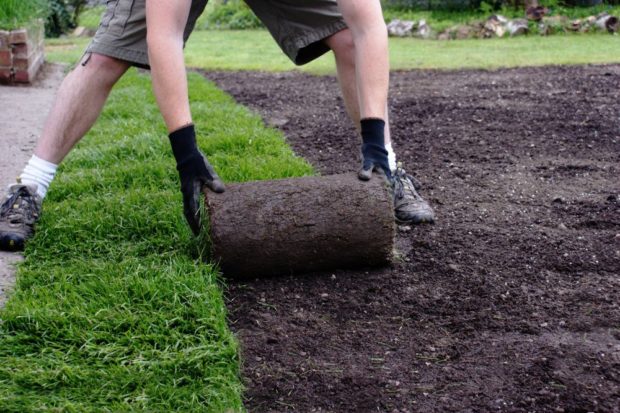
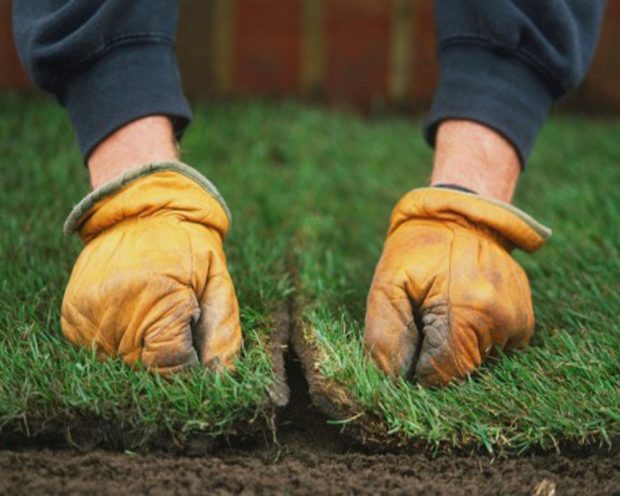

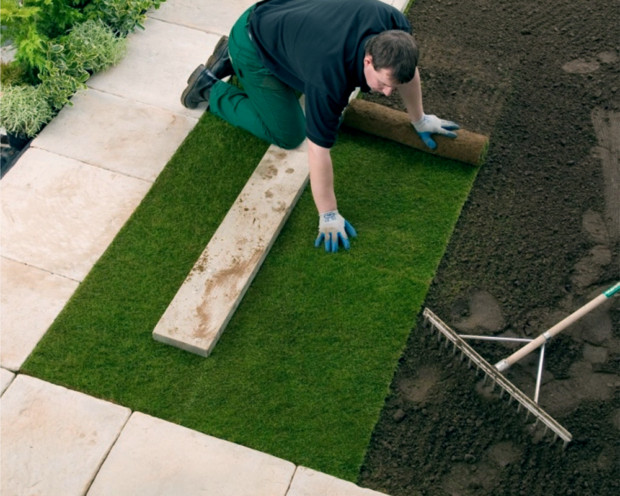

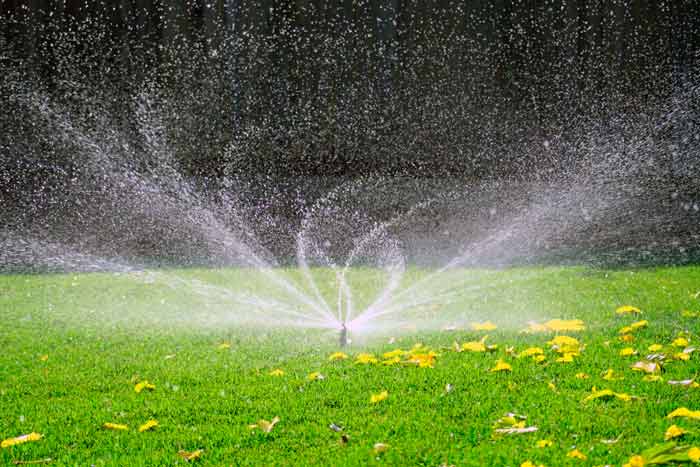
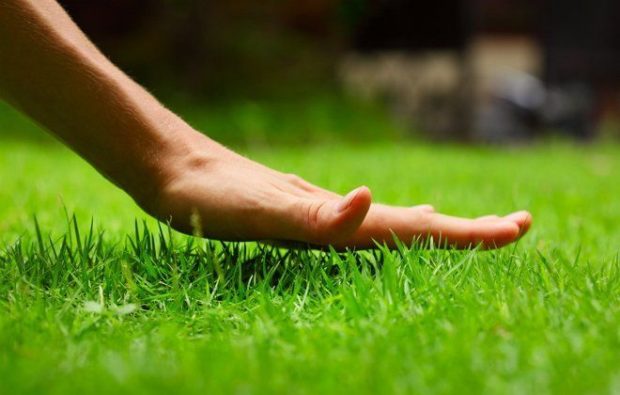
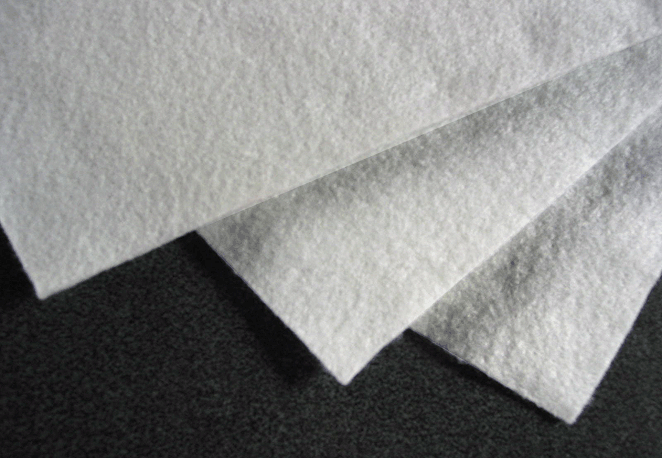

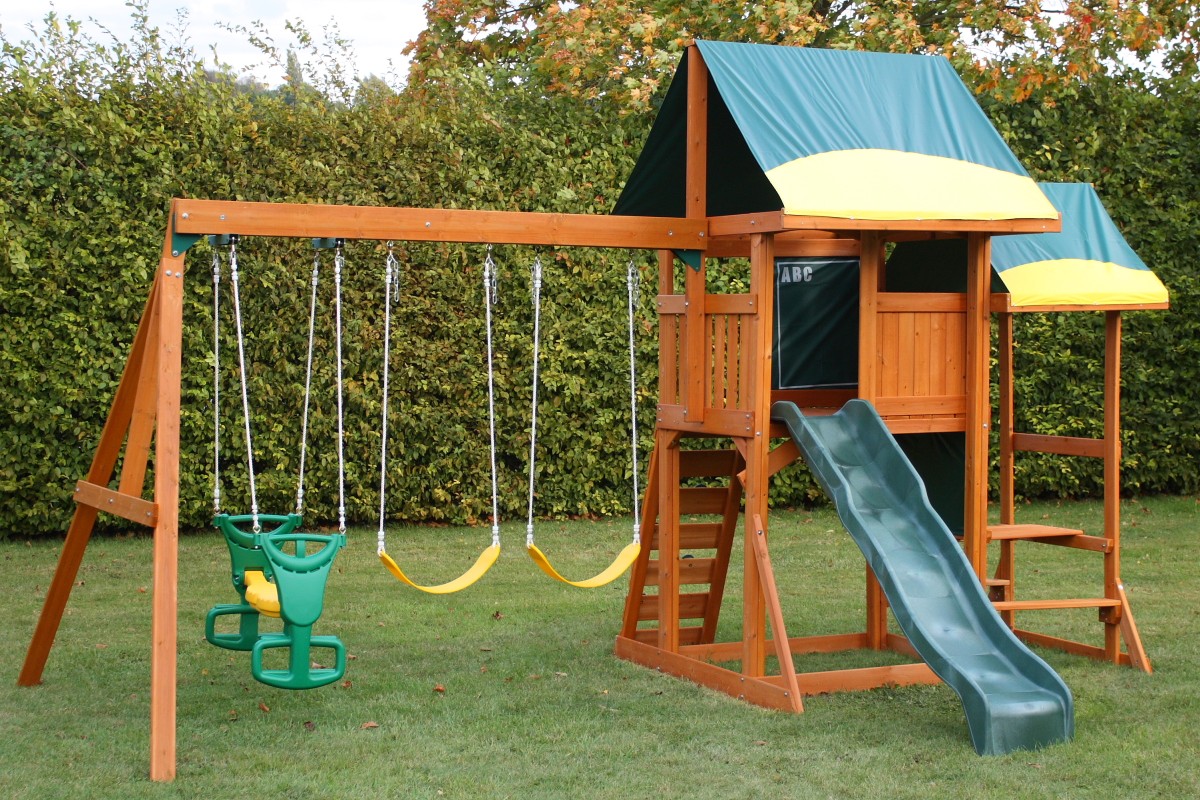

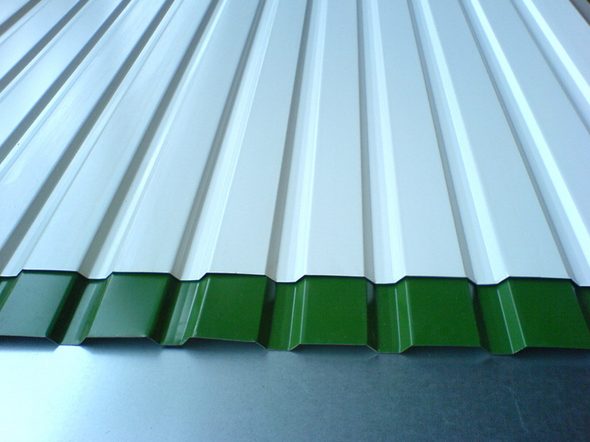
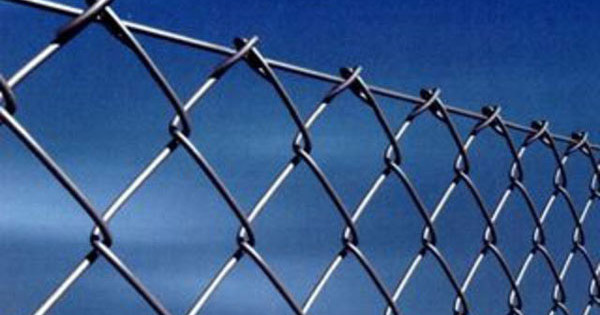
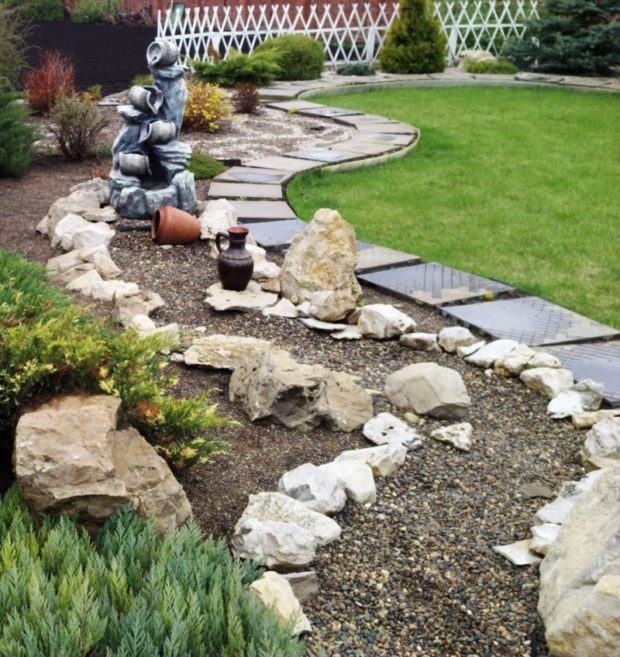
My husband and I for a long time did not dare to lay the lawn ourselves, and we wanted to do this as soon as we bought our site. We thought for about 3 months, but then finally read all the information on the Internet (your article was very useful to us), and realized that it would be faster and easier if someone laid the lawn for us. Our new lawn consists of 100% bluegrass, I read a lot where that is the best grade of grass for lawns.